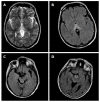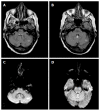Magnetic resonance imaging in the assessment of brain involvement in alcoholic and nonalcoholic Wernicke's encephalopathy
- PMID: 28298967
- PMCID: PMC5334504
- DOI: 10.4329/wjr.v9.i2.72
Magnetic resonance imaging in the assessment of brain involvement in alcoholic and nonalcoholic Wernicke's encephalopathy
Abstract
Aim: To present the typical and atypical magnetic resonance (MR) imaging findings of alcoholic and non-alcoholic Wernicke's encephalopathy.
Methods: This study included 7 patients with Wernicke's encephalopathy (2 men, 5 women; mean age, 52.3 years) that underwent brain MR examination between January 2012 and March 2016 in a single institution. Three patients were alcoholics and 4 patients were non-alcoholics. MR protocol included a T2-weighted sequence, a fluid attenuation inversion recovery (FLAIR) sequence, a diffusion-weighted sequence (b = 0 and 1000 s/mm2), and a contrast-enhanced MR sequence. All MR images were retrospectively reviewed at baseline and follow-up by two radiologists.
Results: All patients with Wernicke's encephalopathy had bilateral areas showing high signal intensity on both T2-weighted and FLAIR MR images in the typical sites (i.e., the periaqueductal region and the tectal plate). Signal intensity abnormalities in the atypical sites (i.e., the cerebellum and the cerebellar vermis) were seen in 4 patients, all of which had no history of alcohol abuse. Six patients had areas with restricted diffusion in the typical and atypical sites. Four patients had areas showing contrast-enhancement in the typical and atypical sites. Follow-up MR imaging within 6 mo after therapy (intravenous administration of thiamine) was performed in 4 patients, and demonstrated a complete resolution of all the signal intensities abnormalities previously seen in all patients.
Conclusion: MR imaging is valuable in the diagnosis of Wernicke's encephalopathy particularly in patients presenting with atypical clinical symptoms, or with no history of alcohol abuse.
Keywords: Brain; Magnetic resonance imaging; Neurodegenerative disorder; Wernicke’s encephalopathy.
Conflict of interest statement
Conflict-of-interest statement: All authors have no conflict-of-interest.
Figures





Similar articles
-
Usefulness of CT and MR imaging in the diagnosis of acute Wernicke's encephalopathy.AJR Am J Roentgenol. 1998 Oct;171(4):1131-7. doi: 10.2214/ajr.171.4.9763009. AJR Am J Roentgenol. 1998. PMID: 9763009
-
MR imaging findings in alcoholic and nonalcoholic acute Wernicke's encephalopathy: a review.Biomed Res Int. 2014;2014:503596. doi: 10.1155/2014/503596. Epub 2014 Jun 24. Biomed Res Int. 2014. PMID: 25050351 Free PMC article. Review.
-
Wernicke's Encephalopathy: Typical Disease with an Atypical Clinicoradiological Manifestation.J Neurosci Rural Pract. 2020 Jul;11(3):487-488. doi: 10.1055/s-0040-1713334. Epub 2020 Jun 12. J Neurosci Rural Pract. 2020. PMID: 32753819 Free PMC article.
-
Nonalcoholic Wernicke's Encephalopathy: A Retrospective Study from a Tertiary Care Center in Northern India.J Neurosci Rural Pract. 2017 Jul-Sep;8(3):401-406. doi: 10.4103/jnrp.jnrp_14_17. J Neurosci Rural Pract. 2017. PMID: 28694620 Free PMC article.
-
CT and MRI of Wernicke's encephalopathy.Radiol Med. 2011 Mar;116(2):319-33. doi: 10.1007/s11547-011-0618-x. Epub 2011 Jan 12. Radiol Med. 2011. PMID: 21225366 Review. English, Italian.
Cited by
-
Acute hearing and visual loss caused by thiamine deficiency.BMC Neurol. 2023 Jul 31;23(1):285. doi: 10.1186/s12883-023-03337-w. BMC Neurol. 2023. PMID: 37525097 Free PMC article.
-
Impairment of Thiamine Transport at the GUT-BBB-AXIS Contributes to Wernicke's Encephalopathy.Mol Neurobiol. 2018 Jul;55(7):5937-5950. doi: 10.1007/s12035-017-0811-0. Epub 2017 Nov 11. Mol Neurobiol. 2018. PMID: 29128903 Free PMC article.
-
Wernicke encephalopathy: a mini review of the clinical spectrum, atypical manifestations, and diagnostic challenges.Front Neurol. 2025 Jul 16;16:1566366. doi: 10.3389/fneur.2025.1566366. eCollection 2025. Front Neurol. 2025. PMID: 40740851 Free PMC article. Review.
-
Beyond the bowel: Wernicke's encephalopathy as a neurological complication of Crohn's disease: A case report.Radiol Case Rep. 2024 May 4;19(8):3013-3018. doi: 10.1016/j.radcr.2024.03.088. eCollection 2024 Aug. Radiol Case Rep. 2024. PMID: 38741688 Free PMC article.
-
Apathetic encephalopathy in thyreotoxicosis: an unsual cause of wernicke encephalopathy and osmotic demyelinating syndrome.Acta Biomed. 2021 Feb 5;92(1):e2021055. doi: 10.23750/abm.v92i1.9473. Acta Biomed. 2021. PMID: 33682841 Free PMC article.
References
-
- Gui QP, Zhao WQ, Wang LN. Wernicke’s encephalopathy in nonalcoholic patients: clinical and pathologic features of three cases and literature reviewed. Neuropathology. 2006;26:231–235. - PubMed
-
- Thomson AD, Marshall EJ. The natural history and pathophysiology of Wernicke’s Encephalopathy and Korsakoff’s Psychosis. Alcohol Alcohol. 2006;41:151–158. - PubMed
-
- Nolli M, Barbieri A, Pinna C, Pasetto A, Nicosia F. Wernicke’s encephalopathy in a malnourished surgical patient: clinical features and magnetic resonance imaging. Acta Anaesthesiol Scand. 2005;49:1566–1570. - PubMed
LinkOut - more resources
Full Text Sources
Other Literature Sources

